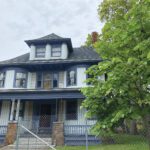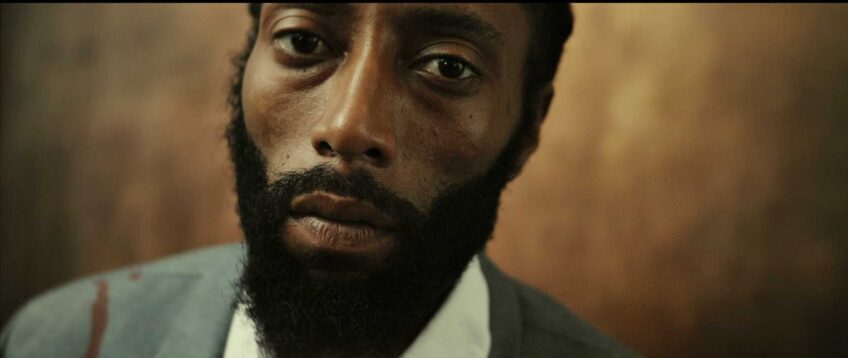Banner [Virtual] Art Gallery
Lucilda Dassardo-Cooper in conversation with artist Bryan McFarlane
![Banner [Virtual] Art Gallery Banner [Virtual] Art Gallery](https://baystatebanner.com/wp-content/uploads/2024/05/McFarlane_1-739x1024.jpg)
View Banner Art Gallery
Banner [Virtual] Art Gallery
Sponsored by City of Boston | Mayor Michelle Wu
This is the 22nd interview in a weekly series presenting highlights of conversations between leading Black visual artists in New England. In this week’s installment, artist Lucilda Dassardo-Cooper talks to artist Bryan McFarlane. The interview has been condensed and edited for clarity.
Jamaica-born, Bryan McFarlane is a painter and a professor of painting and drawing at UMass Dartmouth. He was educated at the Edna Manley College of the Visual and Performing Arts in Kingston, Jamaica, and earned an MFA at the Massachusetts College of Art.
McFarlane splits his time creating abstract and semi-abstract oil paintings at his studios in Boston and China. He has exhibited at the Museum of Fine Arts Boston, the DuSable Museum in Chicago, the Sunshine International Art Museum at Shanghai University and the Commonwealth Institute London, among other places. He is also a regular exhibitor at the National Gallery of Jamaica, which has several of his works in its permanent collection. In addition to China, his artistic journey has taken him to Brazil, Columbia, Ghana, Turkey and Japan.
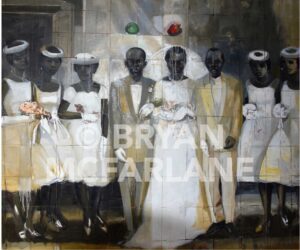
“Eggs that Hatch” (Modern Maroon Wedding), Oil on Linen, 93 x 79.5 inch, 2001, (in the Collection of Caribbean ARTCollection), by Bryan McFarlane. PHOTO: COURTESY OF THE ARTIST
Lucilda Dassardo-Cooper: Bryan, you recently had an exhibition in Jamaica, mostly paintings. Do you work in media other than painting?
Bryan McFarlane: Yes. I work in charcoal, dry medium.
I’ve worked as a sculptor in the past, much earlier … as well as taught a few courses in it at my earlier stage as an assistant professor.
Where were you an assistant professor?
At Andrews University in Michigan and the College of the Holy Cross in Worcester, Massachusetts. [At] UMass, I had to spend four years before I was tenured as an associate professor, and then as a full professor another three or so years after.
You went to the school of art in Jamaica, where you were born and grew up, and I know that you were part of the Maroon community there. Has that affected your art and how you engage with the world?

“Parental Consent” Panel II, 47 x 45 in, watercolor on rag paper, 2023, by Bryan McFarlane. PHOTO: COURTESY OF THE ARTIST
Yes, I studied at the Edna Manley College of the Visual and Performing Arts. That was my first college-level study. I was born in Portland, in the Moore Town area, where you have the Maroon peoples of Jamaica. That aspect of my identity is absolutely important, because it was able to reaffirm who I was as a Black person — a kind of glorious history I would classify as that lived out by Nana, a Maroon woman from Ghana, forcibly taken to Jamaica. She grew up and rebelled against the British system, fought the British soldiers and won the war.
How did you respond to immigrating to the United States? Did it affect your work?
Yes, it affected my work tremendously. At the time, I had gotten a scholarship to go to the Royal College of Art in London from Jamaica. I graduated at the top of my class in painting and won that scholarship, which I was quite pleased about at the time. I couldn’t afford London, so I ended up in Boston.
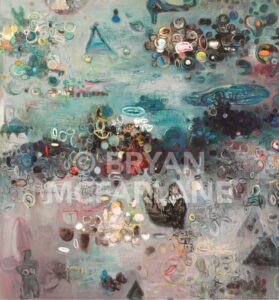
“Birth of a Lion” from Beijing Series, 72 x 60 in, oil on linen, 2009, by Bryan McFarlane. PHOTO: COURTESY OF THE ARTIST
What are the repeating motifs of your art, and what themes and narratives do you seek to bring to the world and to the viewer?
Starting from that era when I was leaving Jamaica, I was very religious then, so my paintings were visionary, kind of revelatory — from the Book of Revelation. Then, I left Jamaica and came to the United States. My work became more about exploring objects and looking at technical issues of painting, looking at the strong Western philosophy regarding expressionism [and] impressionism, looking at abstract expressionism and much of these kinds of very streamlined Western ideas. I kind of removed myself a little from the more Jamaican intuitive and religious way of seeing and into a more concrete way of understanding art and making it — form, color, and all these kinds of structural, formal issues regarding making a composition.
Did you feel you had to put aside your prophetic vision to work within the institutions?
For a while, I put aside more of my intuitive and Jamaican way of seeing and focused on these formal issues because I respected the professors. They didn’t really stop me from being who I was, but I felt it was important to spend a certain amount of time learning the elements of color, texture and that more Western scientific manner from the traditional art school.
Do your current works lean more toward the modern conceptual or the prophetic intuitive vision of your ancestry?
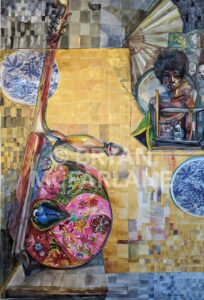
“Dragon Boy,” 61.5 x 42 in, watercolor on rag paper, 2024, by Bryan McFarlane. PHOTO: COURTESY OF THE ARTIST
I think they move more toward a modern intuitive vision of my ancestry, in that identity becomes very central to much of the work that I’m doing currently. Those works reflect largely places where I’ve been, where I’ve lived, such as Salvador, Bahia. I got a Ford Foundation Fellowship to live in Brazil, and I decided to research African culture and retention in that area. So, much of my work was about the Candomblé religion in Brazil.
Tell us a little bit about your experience in China.
I went there in 2007, invited by the Red Gate Gallery. I said I’d stay for a few months, but I ended up staying almost a year. I got a studio and renovated it. I’ve been going there for at least 14, 15 years. I’ve been very productive there.
What draws me to China is the discipline that I found the artists in that environment have and the way in which, as hard workers, they’re very focused. And that motivates me, too. There are many artists who are absolutely amazing. That’s part of what kept me there.
Part of it also is the economic development in China. The environment is developing at a pace that has never been seen by any civilization, technically speaking. That fascinates me. As an artist, I find that amazing. The Western ideas of China are based on power politics, but I’m focused on the creative and mythological aspects of China that make art. I’ve taken the mythology — certain iconic imagery — and integrated it into my paintings. When I travel, I’m influenced by the images that I see and feel, the history and the mythology of a given culture.
View Banner Art Gallery


